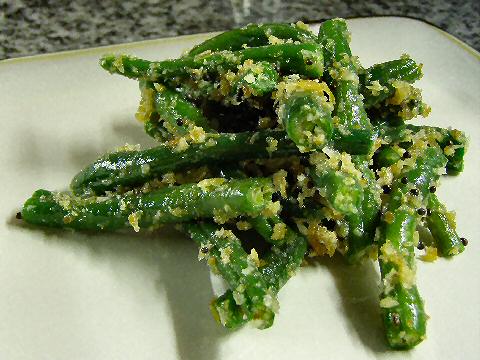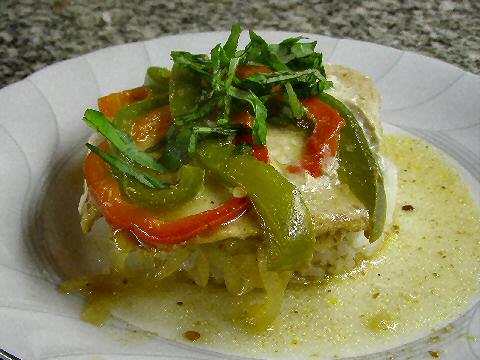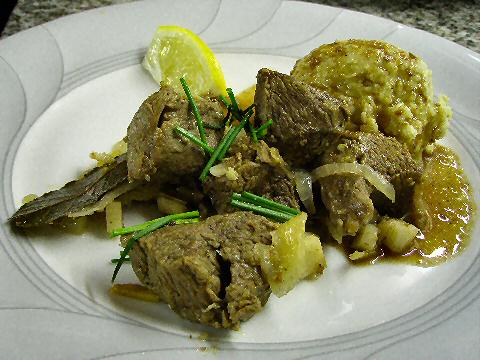“In a country of more than 1 billion people, with 16 official languages and myriad ethnic influences, there is no singular “Indian” cuisine. Instead, hundreds of culinary styles co-exist, each shaped by a unique confluence of geography, history, climate and religion. Each of India’s 28 states and seven union territories has its own specialties. Many American diners are familiar with dishes like chicken tikka masala, lamb saag and tandoori shrimp–specialties that have become the lingua franca of Indian cooking in America. Those northern Indian foods dominate menus in the United States, leaving many customers uninformed about the rich regional variation in Indian cooking.”
– Erica Duecy, Western Indian Cuisine, Nation’s Restaurant News
Buenos Aires – There were so many possibilities for this past weekend’s dinner themes – Italian for Ferragosto, Chinese for the Olympics, Korean Liberation Day, VJ Day, Mother’s Day in Costa Rica, Indian Independence Day… it had been quite some time since we’d last offered up a “sub-continent” dinner, and I happen to like Indian food quite a bit, and besides, it was my friend Belli’s birthday, he’s Indian, and the owner of a local Indian restaurant. That was the one. But which Indian cuisine? We’d gone north before, with our Kashmiri dinner last October, and similar cuisine from neighboring Pakistan the previous March. I thought about splitting things up and offering one course from each of the five major regions of the country, but in the end, decided to focus on just one – but which? Leaving off the north, I randomly… more or less… picked the west, and from there decided on one dish each from five of the more interesting sounding cuisines of the area.

Sometimes it’s the simplest things that are the best – in fact, often – and this dish was one of the evening’s favorites. Fresh green beans were just coming into the markets, and there’s a fairly famous green bean coconut salad from Gujarati cuisine – the premier vegetarian cooking of India. A couple of things were going to have to be compromised – fresh coconuts are not in season here and no asafoetida spice – but then, since when did I ever cook anything in a traditional manner? The original recipe called for powdered roasted peanuts and sugar, I happened upon a Thai sweet peanut drink mix in Chinatown that contained just those two ingredients – how convenient is that? I cooked a kilo and a half of the green beans in boiling salted water until just starting to soften – I wanted them to stay a little crisp. Drained and set aside still warm. Meanwhile, I sauteed two tablespoons of black mustard seeds in about ¾ cup of neutral oil until they were sputtering and popping, then added a finely chopped red onion, continued cooking until just transluscent, and then added ½ cup grated coconut and ¼ cup of the peanut powder and sugar mix, which immediately soaked up all the liquid, and I continued cooking, stirring steadily, until the coconut had just toasted to a medium golden color. I tossed that mixture with the green beans, and added three thinly sliced green jalapeño peppers. Every little while until the dish was cooled I mixed it up a bit. When cool, I added salt to taste and served it at room temperature.
Next up, a dalitoy from the canon of Saraswati cooking. I was originally going to use yellow lentils, but couldn’t find anything but brown or red. I considered using yellow split peas, but then suddenly spotted packages of small yellow pulses labeled “green bean insides”. I assume these are the removed and dried seeds of green beans like those above, so I immediately had a bit of a sequential flow going, you know? Into the blender with several green and red chilies, some ginger, several cloves of garlic, a teaspoon of turmeric powder, enough oil to fry it all in, and just enough water to smooth the whole thing to a smooth paste – figuring it will evaporate right away, which it does. Into the soup pot with this paste, which within a minute or so begins to fry up beautifully, and turns a deep golden yellow color. I added a kilo of the bean seeds, topped the pot up with water, and cooked until they were done, stirring occasionally. Salt to taste, sprinkle with a good amount of chopped cilantro, and there you have a yummy green bean innards soup!

This is the dish from which I probably departed the furthest from the original. I’d settled on a Pomfret, or Butterfish, Curry from Goa, a place that is justifiably famous for its seafood dishes. I found several recipes for the curry, known as
papletchi amti, and all of them sounded quite similar – so I set out to make the curry paste that was called for. And it was awful. Bitter. Disgusting. I honestly have no idea what wasn’t working, I tried it twice with the proportions of the various ingredients called for – maybe it’s simply the difference in the spices available here, maybe it’s one of those cases where someone posted a poor recipe somewhere on the internet and others picked it up and didn’t bother to check it out. All I know is there was no way I was putting that mixture onto anything that we were serving. Into the trash it went. Twice. Instead, I looked over the various ingredients and started combining in proportions that tasted good to me, deciding to leave out the coconut milk since I was already using coconut in three other dishes. I made a paste of garlic, ginger, hot yellow chilies, coriander and cumin seed, and salt. I sauteed thinly sliced yellow onions in that mixture until they were lightly browned. Meanwhile, I simmered some tamarind paste in water until soft, and then strained that mixture into the onions and set that aside. I sauteed some red and green pepper strips, mostly just for color, but also figuring the flavors worked together. Into foil pouches I put a couple of tablespoons of the onion mixture when cooled, laid a fillet of pomfret atop, a few strips of the peppers, and a sprinkle of salt. Then I sealed the packets, and for dinner, put them in the oven to bake the fish in its own juices atop the onion tamarind curry. And then, simply served them atop rice that had some more of the onion mixture atop. Some finely julienned basil completed the dish. Since a couple of the guests informed me after dinner one night that they used to live in Goa and had never eaten a fish curry that good, I’m glad I threw out the bitter stuff…

One of the things that I always “knew” in my early years of culinary experience was that Indians don’t eat beef. But that’s not accurate. Hindus don’t eat beef, at least not traditionally. And Hindus, while the majority, are only 80% of the population of the country. So at least a few of the cows in the land don’t get away with their sacred status, and one place in particular seems to be Kerala, on the southwest coast. Numerous sources cited the Kerala Beef Dry Fry as the ultimate comfort food of the region for those far from home, and after whipping this dish up, or at least my own version, I can understand. I first dry roasted some coriander seeds, black peppercorns, dry red chilies, fennel seeds, cardamom seeds, cloves, and cinnamon stick until smoky and aromatic. I ground those in the food mill to a fine powder, and then coated 1″ cubes of beef in the mixture and left it to sit for about an hour. The I sauteed some julienned ginger, sliced garlic, and chopped preserved coconut (it had a touch of sugar, but not much, and I figured it would balance off against the hot spices) in oil, added the cubes and cooked until lightly browned on the outside, topped it up with water, a splash of cider vinegar, and… a spoonful or two of mayonnaise for richness (suggested by more than one online source, though not at all traditional), brought it to a simmer, covered it, and cooked the meat for about 30 minutes until tender. Then I strained that, setting aside the liquid. For dinner, I tossed the onions and a few fresh bay leaves (no curry leaves available, and several people had suggested that this worked with the dish – onions and bay do work well together) with just a spoonful or two of clarified butter in a big dutch oven, cooking them until they were just softened. I added the beef, which having been simmered already, doesn’t have any additional fat to render – this being the “dry fry” idea – virtually no oil or fat. I cooked this over medium heat, covered, stirring regularly, for about 15 minutes. While that was cooking I reduced the remaining cooking liquid from the beef to a gravy-like consistency. I had made a cauliflower-millet mash (no special recipe, easy to find online), which I heated up with a little butter and milk to give it some richness. We served the beef alongside the mash, topped the mash with the gravy, and a wedge of lemon on the side to give the dish a little brightness (you could, of course, just squeeze the lemon over the dish before serving, but it looks pretty on the plate). Some chopped chives for garnish, and done. I really like this dish, even if my version isn’t fully traditional, and totally understand the comfort food angle!
Many Indian desserts leave me asking “why?” It’s not that they’re not good, they’re just so different from my background that sometimes, especially texturally, they just don’t resonate. I’d decided on a coconut cardamom pudding, which I scooped into pre-baked phyllo tart shells and then topped with sliced bananas and pineapple, a drizzle of honey and a sprinkle of powdered sugar. I like the flavors, but the texture for me falls somewhere around that of a slightly softened gummi bear. Several people really liked it, others clearly weren’t as thrilled – I don’t think I’d make it again, though I might work on something that incorporated those flavors…








My god, the recipe of the green beans really requires asafoetida!? It is onew of the most horrible smelling things I’ve ever seen! And I don’t mean something which could be considered as acquired tastei it is trully hideous, smells of sulphur, rotten eggs, rotten flesh, well rottenness generally and by all means. I bought a small quantity once, out of curiosity, but even wrapped in layers and layers of plastic bags the smell was still strong enough to make the whole room smell awful, so I didn’t dare to carry it in my luggage and threw it away. Actually the stuff is not regularly and easily found in Turkey at all, I came across it only once, in a queer spice shop in the south of the country, where people are somewhat fond of witchcraft. Needless to say, it was sold for that purpose, together with some other weird items, which the hop keepers were shy to talk too much about.
I read in a couple of places that asafoetide is used in Indian cooking but thought it was probably some ancient practice, not really common anymore.
It’s actually quite common in Indian cooking. I have to admit, I’ve never had quite the strong anti-asafoetida reaction you do! It’s possible that whatever you got was somehow “off” – to me it smells like a sort of cross between garlic and leeks, just stronger – which is why in general only a pinch or two is used in dishes, and garlic or shallots are often used as a substitute.
Are you sure the Coconut Cardamom Pudding wasn’t supposed to be made with either rice or tapioca flour?
Those are the kinds i am most familiar with. Although i do agree or desserts do tend to be on the ‘chewier’ side of things.
Can’t wait for my vacation…9 DAYS TO GO!!! First on the agenda is a full on gluttony session at Don Carlos, care to join?
and to poster above.
Asafoetida (Hing) – usually a pinch is fried in oil to kind of seal the smell and flavour the oil and thus the food. Beyond that, yeah it’s a revolting herb my granny used to toast and give me for colds and headaches.
I guess what I had was off as you’ve suggested, or a different variety, it can’t be the same thing that is put in dishes…I like garlic, leeks and onions, and no matter how strong they can smell, they would not come close to the stuff I smelled. Maybe the one used in cooking is subjected to some further processing and this one was unprocessed…I got curious now!
The pudding was actually quite simple – roughly 14 ounces of coconut milk, and 1 cup each of sugar and cornstarch or tapioca flour. That version, the first night, was rubber ball bouncy… I added more liquid the next night in the form of another 8 ounces of sweeteened condensed milk, which gave it a softer, though still chewy texture. Just not my thing – I like the kind of pudding that Bill Cosby would be happy with!
I’m not quite sure that I’m up for a Don Carlos experience at this point – I’m trying to drop a few kilos!
well, hurry up with that. here’s a tip: no pasta, papas, postres post 6 pm. personal 50 pound experience.
If not how about Damblee? I have been having dreams about that plate of boquerones for about 3 months now.
Great to see the passion for food.
[…] a spicy green bean-ish salad that I based on the wonderful Gujurati green bean dish I made at our recent western Indian dinner. It was too hot out to start thinking seriously about some sort of green bean casserole, and thank […]